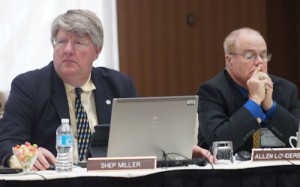by James A. Bacon
It was a routine matter that came before the Commonwealth Transportation Board (CTB) this morning: The Department of Rail and Public Transportation (DRPT) was asking the CTB to approve allocations from the state’s industrial rail access fund. The sums of money were small and the projects were uncontroversial — $450,000 to extend 8,400 feet of railroad track in Prince William County and $40,000 for a rail siding in Petersburg.
The CTB had signed off on dozens of other projects like these with nary a word or even a whisper. But it was different this morning in Tysons Corner as urban at-large representative W. Sheppard Miller III from Hampton Roads grilled Kevin Page, DRPT’s chief operating officer, about the justification for the two projects. Several other CTB members followed with questions of their own. In the end, they went along with the request, but the unusual display of feistiness could spur changes in the way the commonwealth analyzes transportation projects.
One project would pay for construction of staging tracks connecting Eco-Energy Distribution LLC’s to the Nustar Dumfries ethanol fuel-blending facility, Page explained. Prince William County would contribute $150,000 toward the project cost. The other would facilitate the expansion of the BleachTech LLC bleach-manufacturing plant in Petersburg.
Miller had two big questions:
(1) Would the private sector have made the investments anyway without the state contribution?
(2) If not, what Return on Investment does the state generate through jobs created, congestion mitigated and/or taxes paid?
Page had no direct answers. The state uses a standard methodology for grading requests for industrial rail funds, he said, and these two scored in the 50s. By comparison, a home-run project like the APM Terminal in Portsmouth scored in the 90s. The main tangible benefit he cited was that the improvements would facilitate the shift of cargo from trucks on roads to rail cars on tracks. Fewer trucks equals less traffic and improved safety. Also, he said, the agreements contain clawback provisions if the companies don’t divert the promised volume of cargo from the trucks.
But Miller persisted. “Say we take 100 trucks off the road. … Say we save $5,000. But we spend $40,000.” What’s the ROI to the state? How much does the state gain in taxes and reduced welfare payments from putting a factory worker back to work? In the future, he said, he would like DRPT to provide evidence that state support is required to make the private investment happen and to calculate the ROI generated by the state contribution.
Aubrey L. Layne, Jr., Hampton Roads representative, joined in. What is the purpose of the industrial rail access fund, he asked. Is it to promote industrial development — or is it to get trucks off the road?
Allen L. Louderback, a rural at-large representative piled on, questioning state subsidies for the ethanol industry, which is already heavily subsidized. “Given the questions about ethanol … is this really something we want to make a priority?” he asked.
Roger Cole, Richmond district representative, cut to the heart of the matter, when he asked Page: “Do we actually look at the candidate’s ability to finance [the project] by itself?”
The answer: No.
In response to Miller’s suggestion to include more pertinent data in future presentations, the DRPT executive said, “Thank you, Mr. Miller, we’ll take that into consideration.”
When asked after the meeting if Page was politely blowing him off, Miller said, he didn’t think so. In any case, he’ll talk to DRPT Director Thelma Drake about getting the information. When asked if he would like to see similar analysis for larger projects, he said yes. “The analysis gets harder for big projects, but you apply the same logic regardless.”



